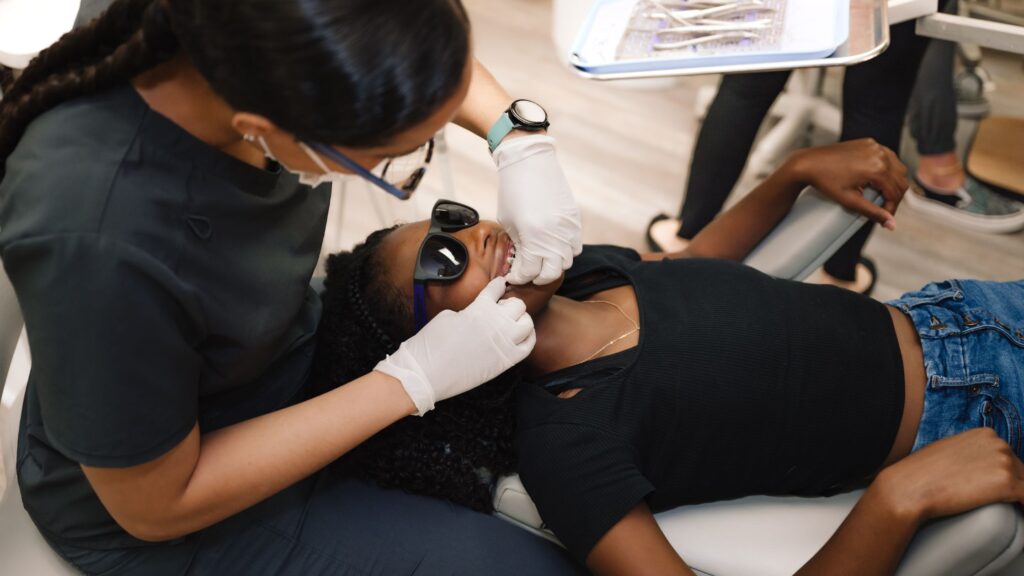In the past, you either had to just live with misaligned teeth or wear traditional braces for several years. There really was no other option. But today, Invisalign® clear acrylic aligners have provided a new way to correct tooth misalignment.
While traditional metal braces may still be best in certain cases, Invisalign® is a great alternative option for most patients. And it offers many distinct benefits that other treatment programs can’t compete with.
Find out what exactly Invisalign® is, how it works, and how it can benefit you or your loved one who suffers from tooth misalignment!
What Exactly Is Invisalign®?
The Invisalign® tooth realignment system is radically different from every other method of tooth realignment that has come before it. And yet, it has been around for long enough that its results have been proven effective. It gets wonderful reviews from patients and dental experts alike and for good reason!
Clear aligners are high-tech orthodontically sophisticated devices that are used to gradually shift teeth into a normal position over a period of months or years. They are manufactured out of transparent plastic – non-toxic plastic that is 100% safe to have in your mouth for long periods of time and that will not leave a bad taste in your mouth.
Invisalign® aligners fit snugly to your teeth because they are custom-designed to fit the contours of each individual patient’s mouth. You use a series of such aligners until tooth misalignment problems have been fully solved.
Specific problems that Invisalign® technology can solve include:
- Overbite.
- Underbite.
- Crossbite.
- Gappy teeth.
- Crooked teeth.
- Open bite.
- And more!
Invisalign® can help in many scenarios provided all or most of a patient’s permanent teeth are already present. Mostly, teenagers and up will use Invisalign, but it is not just for one specific age group.
There really is no situation where you must use Invisalign®. It is simply a better option in many instances. Choosing Invisalign® is also a personal choice most of the time, meaning it is partially based simply upon personal preferences and valuation of Invisalign®’s specific benefits.
How Does Invisalign® Work?
You’ve got a good idea at this point, we trust, on what Invisalign® is. Next, we want to dig a little deeper into exactly how the Invisalign® system works. Why does this system work so well?
Here is a step-by-step breakdown of how the process works:
- Call up your local orthodontist. Schedule an appointment for an initial in-office consultation so you can make an informed decision on whether or not Invisalign® is right for you. This is where you can ask all the relevant questions and get understandable, straightforward answers.
- If you go ahead with it, your orthodontist will formulate a customized treatment plan for you. He or she will take 3-D images of your teeth and jaws and map out how far (and in which direction) each tooth should move with each clear aligner you wear.
- The dental lab will manufacture your Invisalign® clear aligners. Often, this can be done same-day so you don’t need to make a separate trip to pick them up. You leave with six to eight weeks’ worth of aligners, each to be worn for about a two-week time span.
- Put your first aligner in snugly. You need to wear it at least 22 hours a day for two weeks straight. That means you can take it off when taking a shower or eating or brushing/flossing, for example, but you should keep it on while sleeping.
- After the first treatment segment (6 to 8 weeks), you return to the orthodontist to get the next batch of clear aligners. The orthodontist will also give you a quick check-up to ensure all is going well. In some cases, small plastic ridges may be added to the next batch of Invisalign® aligners to make them work a little faster or better.
- Continue to faithfully wear your aligners and get new ones every month to month and a half until treatment is complete. This can be as little as six months or as long as two years. The average treatment time with Invisalign® is just over a year, which is much shorter than with traditional braces.
- Enjoy your new smile! Take that last aligner off and throw it away! Your teeth are now set in their normal, natural positions.
What Are the Key Benefits of Invisalign®?
There are many distinctive benefits of using Invisalign® clear aligners instead of metal braces. People choose this form of tooth realignment treatment for various reasons, but here are the top benefits that many patients most value:
- Invisalign® is, as the name implies, “invisible.” That is, most people won’t even notice you are wearing “braces.” This is a major reason why many prefer clear aligners to highly visible alternatives.
- Greater comfort. With aligners, you won’t have to worry about metal wires and brackets hurting your gums, teeth, tongue, or the inside of your mouth. They are much more comfortable to wear.
- Faster treatment. On average, you will straighten your teeth faster with this system than with other methods. The results, also, are usually long-lasting.
- Greater convenience. Since clear aligners are removable, you can eat with ease and take them off while exercising, too, if desired. For high-impact sports, you’ll just take them out and use a mouthguard during that activity. Clear aligners also don’t interfere with your normal speech patterns. Overall, there are far fewer lifestyle inconveniences with this form of treatment.
- Easy dental hygiene. It can be very difficult and frustrating trying to clean under and around metal braces, and you can’t brush directly under the brackets at all. Since you can remove and reinsert Invisalign® with ease, you can simply follow your normal dental and oral hygiene regimen.
To learn more about Invisalign® and book a consultation, contact Beauchamp Orthodontics today! We are here to assist you and to answer all your questions about using clear aligners to treat tooth misalignment.



